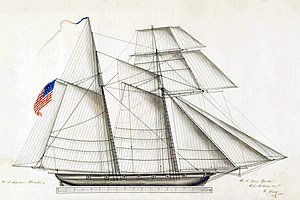USS Alligator (1820)

Alligator.
|
|
| History | |
|---|---|
| Name: | USS Alligator |
| Builder: | Boston Navy Yard |
| Laid down: | 26 June 1820 |
| Launched: | 2 November 1820 |
| Commissioned: | March 1821 |
| Fate: | Wrecked, 23 November 1822 |
| General characteristics | |
| Type: | Schooner |
| Tonnage: | 198 |
| Length: | 86 ft (26 m) |
| Beam: | 24 ft 7 in (7.49 m) |
| Depth: | 10 ft 4 in (3.15 m) |
| Propulsion: | Sail |
| Speed: | 8 knots (15 km/h; 9.2 mph) |
| Armament: | 12 × 6-pounder guns |
The third USS Alligator was a schooner in the United States Navy.
Alligator was laid down on 26 June 1820 by the Boston Navy Yard; launched on 2 November 1820; and commissioned in March 1821 — probably on the 26th — with Lieutenant in command. On 6 June 1996, the site of its wreck was added to the U.S. National Register of Historic Places.
When Alligator put to sea from Boston, Massachusetts on 3 April, she embarked upon a twofold mission. Lt. Stockton had been given command of Alligator as a result of his dogged efforts to persuade the Secretary of the Navy, Smith Thompson, to pass over several officers senior to him so that, in addition to cruising the west African coast to suppress the slave trade, he might also search for and acquire a stretch of the coast of Africa for the American Colonization Society. The Society had previously established a colony of former American slaves on the coast, but the climate in that area was so debilitating and unhealthy that the colony had disintegrated. Representatives of the Society therefore had approached Stockton to aid them in the acquisition of a more suitable parcel of land.
After a stop at New York to complete her crew, the warship sailed for waters off the west coast of Africa where she cruised from Cape Verde south to the equator in an effort to stem the illegal exportation of slaves from Africa to the Americas. Though she captured several slavers, among which were the schooners Mathilde, L'Eliza, and Daphne, perhaps her greatest contribution was the selection and acquisition of the territory around Cape Mesurado by her commanding officer and a representative of the American Colonization Society, Dr. Eli Ayers, who was embarked in Alligator for that purpose. The negotiations with the primary native chieftain, King Peter, involved great danger since his people were noted slavers themselves. Initial negotiations went well, but King Peter failed to appear at the appointed time to conclude the treaty. Instead, he repaired to a place some 20 miles inland leaving Stockton with the challenge to follow him to his retreat inland "if he dare." Thereupon, Stockton and Ayres took up the figurative gauntlet and headed inland. The result of their efforts — the parcel of coast around Cape Mesurado — was the germ from which the Republic of Liberia grew.
...
Wikipedia
